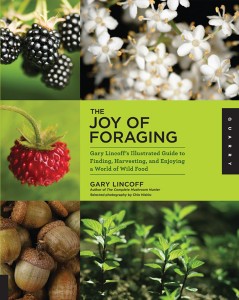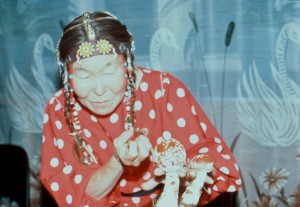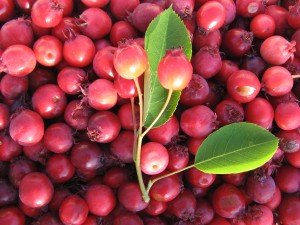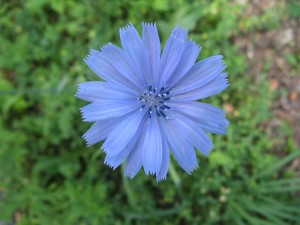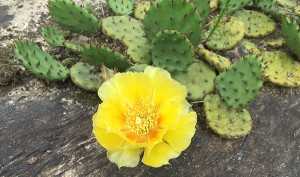Chicory flower
BOT 335 / ETHNOBOTANY: A FIELD STUDY
Instructor: Gary Lincoff
Szechuan Peppercorns from the NYBG tree
Prickly Pear flower (Opuntia halimifolia) – NYBG Native Plant Garden
Ethnobotany is on the front lines in the race against time. Explore how plants are a part of daily human life, from foods and clothes to medicines, shelter, tools, and spiritual practices, and learn how to identify both temperate and tropical plants and their applications for these purposes. Study and compare the flora that traditional European peoples used to achieve these ends with those used by native peoples in North America and the Amazon, Africa (Madagascar and South Africa), and tribal people in the Russian Far East. [Dress for the weather. Classes will include field trips to identify local plants used by native peoples.]
4 Wednesdays, June 8, 15, 22, and 29, 2016……10 am – noon
————————————————————————–
Ethnobotany class June 15, 2016
Plants seen in class & on grounds of NYBG
Mulberry (Morus alba) – The “white” mulberry gives both white & reddish/purple fruit (on different trees)
Linden (Tilia spp.) – We saw the LIttleleaf Linden, but the American Linden has the largest leaves among our lindens, and the European Silver Linden has the most fragrant flowers.
Lindens are sequential in blooming, starting with the Little Leaf and ending with the Silver. In between are a half dozen other species and cultivars.
Szechuan Peppercorn Tree (also known as Prickly Ash) – Xanthoxylum. The American species is X. americanum. The one we saw is X. sinensis.
There is a video in today’s New York Times (online, of course) about the numbing spice made from the outer skin of the fruit of this tree. (see photo above – red fruit in bowl).
Prickly Pear (native – and local!) – Opuntia halimifolia. Cacti are American plants, not found anywhere else on the planet, unless introduced. All parts are edible – when properly prepared.
The tiny spines on the pads must be removed before the pads (nopales) can be used. The fruits are called prickly-pears (there are other market names used, as well).
Persimmon (native – and local) – Diospyros virginiana – is a fruit that in the wild has to experience cold weather to render it palatable (too astringent otherwise).
Asian cultivated persimmons can be eaten out of hand like apples.
Blueberries (Vaccinium) and Huckleberries (Gaylusaccia) are two look-alike shrubs native to our area, and common in our woods. Both have choice and tasty fruit. Huckleberry leaves have
distinctive yellow dots on the undersides of their leaves…..and the “berries” have fairly large seeds, about 7 or so per berry. Blueberry seeds are nearly invisible.
To be continued…….
Brought into class – SEAWEEDS gathered along the Bronx shore in Pelham Bay Park
Sea Lettuce (Ulva), a green seaweed
Bladderwrack (Fucus), a brown seaweed
a finely branched red seaweed
Irish Moss (Chondrus), a red seaweed
————————————————————————–
Ethnobotany class June 8, 2016
Plants seen on the grounds of the NYBG
(note: “-ceae” refers to the plant family)
Woody Plants
Amelanchier sp. (Juneberry)…Rosaceae
Also known as Serviceberry, Shadbush, etc.
Used by native Americans in making pemmican, a portable snack food for journeys…Best now eaten out of hand, on cereal, in pies.
It’s easier to spot these in bloom – in April.
Prunus serotinus (Black Cherry)…Rosaceae
Our most common weed tree. Flowers in early May; fruit is ripe in August; bitterish but makes a good jelly; also used in cordials, etc.
Rubus phoenocalasius (Wineberry)…Rosaceae
Aka Japanese Raspberry. In leaf, raspberries can be differentiated from blackberries by their leaves, which are white below, not green; fruit is easily recognized: raspberries resemble bumpy thimbles! Wineberry is ripe in early July.
Cornus kousa (Kousa Dogwood)…Cornaceae
This is the ornamental dogwood that flowers after Flowering Dogwood; typically throughout June; the fruit ripens in August and resembles raspberries, and is edible, but not as tasty or as juicy.
Quercus spp. (Oaks)…Fagaceae
Most oaks divide into 2 groups: those with rounded lobed leaves (the white oak group) and those with pointed lobed leaves (the red oak group). The white oaks take one year to mature their acorns, the red oaks two. The red oak group acorns are considerably more bitter than the white oak group. Both groups need processing to be used for food – either boiling 1 to 2 hours or soaking for a couple of days.
Acorn flour is available in Korean markets (32nd St.). Acorn meal can be used in baking; also as a ground meat substitute…
Sambucus canadensis (Elderberry)…Caprifoliaceae
Elderberry flowers can be dipped in an egg & flour batter, with a pinch of baking powder, then fried lightly, seasoned with a sprinkle of powdered sugar and a splash of squeezed orange – and served.
Elderberries are ripe in August – and are used in making elderberry wine and elderberry jelly.
Acer (Maples)…Aceraceae now Sapindaceae
We looked at Norway Maple, which has the batman-sign-like leaf lobe & the milky sap when the leaf is severed from the stem. Red Maple syrup is marketed in some areas, but Sugar Maple is the standard maple for tapping for sap to boil for syrup. The season for tapping is February-March.
Morus alba (Mulberry)…Moraceae
The common mulberry in our area is Morus alba, and it can have white or reddish or even black fruit when ripe. The white fruit is sugary sweet, while the black is tart. Mulberry is mostly dioecious, meaning that there are male and female trees, and only the female, of course, bears fruit. Mulberry is ripe for gathering in mid-June.
Taxus (Yew)…Taxaceae
The yews bookending the entrance to the building are related to the yews in the Pacific Northwest (and also Florida) that have been shown to be the source for an anti-cancer compound called Taxol. It has been synthesized and is now used in treating various cancers, especially ovarian cancer.
Herbaceous Plants
Garlic-mustard (Alliaria petiolata)…Brassicaceae
This European plant has a history of use dating back to 6000 BCE. It’s use as a green, a spice, a diuretic has long been known. It was brought to the U.S. as a medicinal plant in the 1800’s but only became an “invasive” recently. It interferes with adjacent tree roots absorbing water and nutrients, killing the trees. It’s best collected for food (as a pesto substitute for basil) in late winter and early spring, before the flower stalk rises.
Wood-sorrel (Oxalis sp.)…Oxalidaceae
Two plants in our area have a distinctly lemony flavor – wood-sorrel and wild sorrel (Rumex acetosella). They are not related but contain similar compounds, and both can be used to make the classic chilled European soup called Tchav, which is traditionally made with Garden Sorrel (another species of Rumex). Wood-sorrel can be gathered anytime it’s found, and it’s nearly always there, wherever you are in urban/suburban America.
Stinging Nettle (Urtica dioica)…Urticaceae
This weed is the classic European early spring tonic – often the first green to appear after winter – and nettle festival are held to celebrate it in parts of Europe. It’s common here in wet areas, along waterways. Gather when it first appears – in April – before it grows up – and use shears and gloves when gathering. Boil the leaves for one minute (to ‘defang’ the plant) and use in soups and sauces (as pesto). Used to treat muscle pain, etc.
Broad Dock (Rumex obtusifolia)…Polygonaceae
“Dock in, nettle out” is what country people learn. That is, if you have somehow gotten into stinging nettle, dig up the dock plant and rub the mucilaginous material at the top of the root on the irritated skin, and the “nettle rash” will subside. Dock is a species of Rumex, related to sorrel, and, though Broad Dock is bitter to the taste, if boiled, it becomes sour, and can be used as a sour green.
Lady’s Thumb (Polygonum sp.)…Polygonaceae
Quite a number of knotweeds are weedy plants in urban/suburban America. Japanese Knotweed is the largest of them (up to 8 feet tall), and Prostrate Knotweed is the smallest. They all have a distinctive bandage-like wrapper (called an ochrea) where the leaf and stem meet. The plants are edible but rarely gathered. [Japanese Knotweed is the exception, being asparagus-like when it first appears in the spring, and tasting somewhat of rhubarb. It is gathered in April, when it is about 6-8” high, and steamed. Some people make a compote with Japanese Knotweed and strawberries.]
Dandelion (Taraxacum officinale)…Asteraceae
Dandelion is the poster-child of bitter greens, something that some people love and others can’t stand. It’s a common farmer’s market green, often sold in a number of varieties. The wild plant is ubiquitous in urban/suburban America, and is almost always in bloom, though its peak flowering time is April. The greens are gathered, preferably before the plant flowers, and they can be boiled. Some people boil them and then cook them in bacon fat, something other people find abhorrent. Still, the greens are commonly eaten in the countryside, and the flowers are used to make dandelion wine, and the roots are gathered to make a kind of “coffee.” Chicory-coffee is very similar, made with a blend of the related chicory root and coffee. [Dandelion was thought to be important enough to deserve a place in one of the Unicorn Tapestries – on view up at the Cloisters.]
Mugwort (Artemisia vulgaris)…Asteraceae
Mugwort is an Artemisia, related to Tarragon, as well as Artemisia absinthium, the volatile ingredient in the infamous Green Fairy drink, Absinthe. Mugwort is also related to another species of Artemisia that is being used in Asia to treat malaria. Mugwort is rarely gathered for food, but bits of it have been put into sushi by a few avid foragers.
Clovers (Trifolium spp.)…Fabaceae
There are many different kinds of clover growing in lawns and along path sides in urban/suburban America. Two of the most common are the white clover (Trifolium repens) and the red clover (Trifolium pratense). The leaves are edible but herby, while the flowers on a sunny, hot day, have a decidedly sweet flavor to them. They can be sprinkled into salads. Clover sprouts are sold in markets, but you can harvest and grow your own, if you like them……[Another clover, Sweet Clover (Melilotus officinalis) is the often fragrant smell you detect when a lawn mower has come through an area.]
Pokeweed (Phytolacca americana)…Phytolaccaceae
This all to common weed in our area is the famous southern green known as “poke sallet” – a cooked spring green. It’s poisonous eaten raw – or even when it’s full grown, but it’s young shoots can be boiled and enjoyed in early May when it first appears.
—————————————————————————————–
From Claude Levi-Strauss’s “The Savage Mind” (pages 39-43):
A note on traditional taxonomy:
“The Dogon (a people in the Sudan, in Africa) divide plants into twenty-two main families, some of which are further divided into eleven sub-groups The twenty-two families listed in the appropriate order, are divided into two series, one of which is composed of the families of odd numbers and other of those of even ones. In the former, which symbolizes single births, the plants called male and female are associated with the rainy and the dry seasons respectively. In the latter, which symbolizes twin births, there is the same relation but in reverse. Each family is also allocated to one of three categories: tree, bush, grass; finally, each family corresponds to a part of the body, a technique, a social class and an institution…..The Navaho Indians, who regard themselves as ‘great classifiers’, divide living creatures into two categories on the basis of whether they are or are not endowed with speech. The category of creatures without speech consists of animals and plants….Plants are named on the basis of three sorts of characteristics: their supposed sex, their medicinal properties, and their visual or tactual appearance (prickly, sticky, etc.). Each of these three groups is divided into three further groups according to size (large, medium, small). The classification is of the same kind throughout the reserve of some twenty-five thousand square miles, in spite of the dispersion of its sixty thousand occupants over this rather extensive territory….Each animal or plant corresponds to a natural element, itself dependent on rites whose extreme complexity among the Navaho is well known……The Omaha Indians consider one of the main differences between themselves and the whites to be that ‘Indians never pick flowers’ (i.e., for pleasure). For ‘plants have sacred uses known (only) to the secret owners.’ Even soapweed which is commonly used for steam baths to cure toothache, earache or rheumatism is lifted as thorugh it were a sacred root…..When a medicine man of eastern Canada gathers roots or leaves or bark for medicines, he is careful to propitiate the soul of each plant by placing a tiny offering at its base. For he believes that without the cooperation of the soul the mere ‘body’ of the plant can work no cures.”
And a note on traditional peoples as botanists and horticulturists:
“The Aymara Indians of the Bolivian plateau…are able experimenters in the preservation of foodstuffs. It was by direct imitation of their technique of dehydration that the American army was able to reduce the rations of powdered potatoes sufficient for a hundred meals to the volume of a shoe box……Over two hundred and fifty varieties of potatoes are still distinguished in native vocabulary and the figure was certainly higher in the past. This taxonomy operates by using a term to designate the variety and adding a qualifying adjective for each sub-variety. Thus the variety ‘imilla’ (‘girl’) is subdivided either according to color (black, blue, white, red, blood-colored) or according to other characteristics such as grassy, insipid, egg-shaped, and so on. There are about twenty-two main varieties which are subdivided in this way. In addition, there is a general dichotomy between those which may be eaten after simple cooking and those which can only be eaten after being alternately frozen and fermented.”
———————————————————————————————————–
Question: What is the Doctrine of Signatures? When did this idea arrive on the stage of history, as we know it? When was it in vogue and for how long? What is its practical use today?
Why does a walnut look like a brain? Why does bloodroot have a red root? Why do kidney beans resemble kidneys? Why does ginseng root resemble a human torso?
————————————————————————————————————
Read: Alexander Von Humboldt’s ‘Personal Narrative of a Journey to the Equinoctual Regions of the New Continent,” the edited Penguin Classics edition. It’s got more good ethnobotany in it than many books you are likely to consult!
————————————————————————————————————
Class 1: Introduction. Using European ethnobotany as a standard against which to compare other cultures. [Field trip outside of class time – to be scheduled - to the Cloisters to study European ethnobotany of the Middle Ages]…..Who uses (or has used) which plants for what purposes?
a) Food & Drink
b) Medicine & Poisons
c) Shelter
d) Clothing
e) Dyes
f) Tools and Weapons; Fire & Firewood
g) Utensils, Cordage
h) Containers
i) Transportation
j) Spiritual Practices (Drugs, Rituals)
————————————————
Some common plants used by indigenous peoples on the grounds of the NYBG
How many of these common plants can you place in botanical families?
All-heal (Prunella vulgaris)
Amaranth (Amaranthus retroflexus)
Blackberry (Rubus sp.)
Broad Dock (Rumex obtusifolius)
Bull Thistle (Circium vulgare)
Creeping Charley (Glechoma hederacea)
Dandelion (Taraxacum officinale)
Evening Primrose (Oenothera biennis)
Field Garlic (Allium vineale)
Garlic-mustard (Alliaria petiolata)
Hawthorn (Crataegus sp.)
Japanese Knotweed (Fallopia japonica)
Jewelweed (Impatiens capensis)
Juneberry/Serviceberry (Amelanchier sp.)
Lamb’s quarters (Chenopodium album)
Mugwort (Artemisia vulgaris)
Mulberry (Morus alba)
Oaks (Quercus spp.)
Plantain (Plantago major)
Poison-ivy (Toxicodendron radicans)
Prickly Lettuce (Lactuca serriola)
Sheep Sorrel (Rumex acetosella)
Stinging nettle (Urtica dioica)
White Clover (Trifolium repens)
Willow (Salix sp.)
Wood Sorrel (Oxalis stricta)
Yew (Taxus sp.)
————————————————————————————————-
Class 2 : Native American ethnobotany – North American and Amazonian cultures
Slides of plants used by Amazonian Indians
Achiote (Bixa orellana): fruit
Ayahuasca (Banisteriopsis caapi & Psychotria viridis):
Aguaje (Mauritia flexuosa): palm fruit
Algodon (Gossypium sp.): cotton
Calabash (Crescentia cujete): container
Chambira (Astrocaryum chambira): palm
Chonta (Euterpe edulis): heart of palm
Chuchuwasi (Maytenus sp.): medicine
Coca (Erythroxylon): coca
Cocona (Solanum topiro): tart fruit
Cupuasu (Theobroma sp.): ‘chocolate’ fruit
Embauba (Cecropia peltata): anti-inflammatory tea
Guaba (Inga sp.): Inga bean
Guanabana (Anona muricata): custard apple
Lecythidaceae – blowgun dart holder
Liana cut for drinking stored water
Macambo (Theobroma spl.): ‘chocolate’ fruit
Oje (Ficus insipida): medicine
Pomarosa (Eugenia): water apple
Pijuayo (Bactris gasipae): palm fruit
Rubber tree (Hevea brasiliensis): commercial rubber
Sapodilla (Manilkara sapota): fruit
Sounding log: hollowed hardwood log
Sugar cane, Cana dulce (Saccharum sp.)
Topa (Ochroma pyramidale): balsa rafts
Uvilla (Pourouma cecropiaefolia): fruit
Umari (Poraquieba sericea ): fruit
Yuca (Manhhot esculenta): manioc
————————————————————————————————–
Class 3 : African ethnobotany – Madagascar and native South African plant use
MADAGASCAR
Jolly, Alison. “A World Like Our Own: Man and Nature in Madagascar.”
“Ethnobotanical and Economic Value of Ravenala madagascariensis in eastern Madagascar,” by Nivo Rakotoarivo, et al., J. Ethnobio. Ethnomed., 2014. [Free on the Internet]
Ravenala madagascariensis is the Traveler’s palm, a plant related to Strelitzia (Bird-of-Paradise), and native to Madagascar.
It has a large number of uses in Madagascar, including:
Food (the plant heart)
Construction of houses
Floor (trunk)
Roof (leaves)
Wall (petioles & trunk)
Doors (petioles)
Utensils, etc.
Tables (trunk)
Beds (trunk)
Dishes (leaves)
Spoons (leaves)
Baskets (petioles)
Fishing nets (leaf rachis)
Mats (petioles)
Winnowing trays (petioles)
Ropes (petiole fibers)
Medicine
Dizziness and stomach ache (leaves)
Other uses
Host for edible larvae (trunk)
“Ethnobotanical Reputation of Plant Speices from Two Forests of
Madagascar,” by Ivan Norscia, et al., S. African J. Botany, 2006.
[Free on the Internet]
Of 12,000 vascular plants in Madagascar, 80% are endemic.
A group of 200 were selected for the study, and 45 species (in 28 families) were found to be used by local peoples. 1/3 were used for gastro-intestinal purposes: diarrhea, abdominal pain, parasitic worms.
¼ were used to treat malaria and fever. 1/3 were used for colds, skin conditions, and inflammation.
“Ethnobotanical Research at Analalava, Madagascar: A Photo Essay,” by Will McClatchey, et al., Ethnobotany Research Applications 3:371 (2005)
[Free on the Internet]
—————————
THE BUSHMEN OF SOUTHERN AFRICA
Lee, Richard, B. and Irven DeVore, editors. “Kalahari Hunter-Gatherers: Studies of the !Kung San and Their Neighbors.” Harvard U. Press, 1976.
Some major foods: Bauhinia (bean), Citrullis (melon), Cucumis (tuber), Grewia (berry), Ochna (berry), Scilla (bulb), Terfezia (truffle), Aloe (stalk), Rhaphionacme (tuber)……about 80 plant food altogether
Johnson, Bonnister, and Wannenburgh. “The Bushmen.” Struik, Cape Town, 1999.
“Traditional Peoples Today: Continuity and Change in the Modern World,” American Museum of Natural History, vol. 5. (see pp. 140-143)
Film: “The Gods Must Be Crazy”
————————————————————————————————–
Class 4 : Ethnobotany of tribal people of the Russian Far East
Grades: Grades will be based on an exam plus a project or research report.
REFERENCES:
General:
Cox, P. and M. Balick. “Plants, People, and Culture: the Science of Ethnobotany”
Duke, James. “Green Pharmacy”
Eliade, Mircea. “The Sacred and the Profane”
Eliade, Mircea. “Shamanism”
Harlow, W. “Trees of the Eastern and Central U.S. & Canada”
Heywood, V.H. “Flowering Plants of the World”
Lee, R. and R. Daly. “The Cambridge Encyclopedia of Hunters and Gatherers”
Lewis & Lewis. “Medical Botany”
Schultes, R. “Golden Guide: Hallucinogenic Plants”
“Traditional Peoples Today: Continuity and Change in the Modern World,” vol. 5. American Museum of Natural History
Class 1: European ethnobotany
Glob, P.V. “The Bog People”
Grieve, M. “A Modern Herbal”
The Cloisters Museum and Garden
Class 2: Native American and Amazonian ethnobotany
Bolton, R.P. “Indian Life of Long Ago in the City of New York”
Chestnut, V.K. “Plants used by the Indians of Mendocino County California”
Densmore, F. “How Indians Use Wild Plants for Food, Medicine & Crafts”
Gunther, E.”Ethnobotany of Western Washington”
Kavasch E.B. “Enduring Harvests: Native American Foods and Festivals for Every Season”
Kazimiroff, T. “The Last Algonquin”
Lamb, F. Bruce. “Wizard of the Upper Amazon”
McKenna, Terence. “Food of the Gods”
Moerman, D. “Native American Ethnobotany”
Parker, A. “The Indian How Book”
Stewart, H. “Cedar: Tree of Life to the Northwest Coast Indians”
[Taylor, R. “Plants of Colonial Days”]
Vogel, Virgil. “American Indian Medicine”
Class 3: African ethnobotany: Madagascar and South African
Jolly, Alison. “A World Like Our Own: Man and Nature in Madagascar”
Lee, R. and I. DeVore. “Kalahari Hunter-Gatherers: Studies of the !Kung San and their Neighbors”
Also, The Cambridge Encyclopedia of Hunters and Gatherers
Class 4: Ethnobotany of tribal peoples of the Russian Far East
Fitzhugh, W. and A. Crowell. “Crossroads of Continents: Cultures of Siberia and Alaska” Smithsonian Institution Press
“Mukhomor” – on YouTube
“Pegtymel: Indigenous Peoples of the Russian North” – Film by Andrei Golovnev
Also, The Cambridge Encyclopedia of Hunters and Gatherers
————————————————————————————–
20 Major Plant Families:
Apiaceae (Carrot Family)…..food & poisons
Araliaceae (Ginseng Family)…..medicine
Arecaceae (Palm Family)…..food, shelter, clothing
Asclepiaceae (Milkweed Family)…..food, medicine, poison
Asteraceae (Aster Family)…..food, medicine
Betulaceae (Birch Family)…..food, medicine
Brassicaceae (Mustard Family)…..food, medicine, dyes
Cannabaceae (Hemp Family)…..fiber, medicine & drugs
Fabaceae (Bean Family)…..food, medicine
Fagaceae (Beech Family)…..food, medicine, construction
Malvaceae (Mallow Family)…..food, medicine, cloth
Oleaceae (Olive Family)…..food, medicine, construction
Papaveraceae (Poppy Family)…..food, medicine
Poaceae (Grass Family)…..food, medicine
Ranunculaceae (Buttercup Family)…..medicine and poisons
Rosaceae (Rose Family)…..food, medicine
Rubiaceae (Madder Family)…..food & drink, dyes
Rutaceae (Citrus Family)…..food, medicine
Solanaceae (Nightshade Family)…..food, medicine, poisons
Vitaceae (Grape Family)…..food & drink, medicine
Comparative Uses of Plants
North America
Northeast
Plant food staples: corn, squash & beans, maple syrup
Medicine: see Vogel
Drugs: tobacco
Shelter: slippery elm frame, birch covering
Clothing
Dyes: bloodroot
Tools & weapons : bow & arrow; hickory, black locust
Southeast: osage orange bows
String, cord: dogbane, linden
Containers, utensils: birch bark
Transportation: chestnut canoes for ocean; birch bark for lakes
Midwest
Plant food staples: wild rice, corn
Medicine: see Densmore
Drugs: (charms: acorus, dogbane, milkweed)
Shelter: hophornbeam frames; birch covering
Clothing
Dyes: bloodroot, butternut, alder
Tools & weapons: maple paddles, hickory bows
String, cord: linden, slippery elm
Containers, utensils: birch
Transportation: birch bark canoes
Northwest
Plant food staples: Camassia quamash, huckleberries
Medicine: see Erna Gunther
Drugs: kinnikinick, (charm: western hemlock)
Shelter: western red cedar
Clothing: cedar
Dyes: western hemlock, alder, barberry roots
Tools & weapons: yew for bows & arrows
String, cord: cedar; sitka spruce roots, nettle
Containers, utensils: cedar, alder, maple
Transportation: cedar canoes
California
Plant food staples: acorns
Medicine: see V.K. Chestnut
Drugs
Shelter: conifers, covering: conifers
Clothing: dogbane, iris, willow
Dyes: alder, sumacb, mesquite
Tools & weapons: bows (yew, libocedrus) & arrows (alder); black willow bow & Carrizo arrows, yucca quiver; fish poison: buckeye
String, cord: dogbane, milkweed, iris
Containers, utensils: redbud, sumach, sedge
Transportation: sequoia boats
Southwest
Plant food staples: cacti, acorns, beans, corn & squash
Medicine
Drugs: tobacco; peyote
Shelter: ocotillo
Clothing
Dyes: mesquite
Tools & weapons: ironwood trees, mesquite
String, cord:
Containers, utensils:: gourds, yucca, willow, juniper
Transportation
South America: Amazon
Food: manioc (staple), various fruits
Medicine: see F. Bruce Lamb
Drugs: ayahuasca, Virola, coca
Shelter: hardwood posts, palm thatching
Clothing: beaten bark
Dyes: achiote
Tools & weapons: blowguns & curare; spears; bows
String, cord: palm
Containers, utensils: calabash
Transportation: dugouts
———————————————————————————————–
Something we should consider is the use of SMUDGING, the burning of herbs in different cultures around the world. Different plants are used for scent and ritual cleansing. Some of these have been shown to be effective medicinally, that is, to “cleanse” the air of a variety of pathogenic microbes. We’ll look into some of these plants in our class work.
———————————————————————————————–
Memorial Sloan Kettering Cancer Center [http://www.mskcc.org/cancer-care/integrative-medicine/about-herbs]



